南方医科大学学报 ›› 2024, Vol. 44 ›› Issue (6): 1117-1125.doi: 10.12122/j.issn.1673-4254.2024.06.12
房锦存1,2,3( ), 刘立威2, 林俊豪1(
), 刘立威2, 林俊豪1( ), 陈逢生1,3(
), 陈逢生1,3( )
)
收稿日期:2023-11-09
出版日期:2024-06-20
发布日期:2024-07-01
通讯作者:
林俊豪,陈逢生
E-mail:fangjincun@126.com;l_i_n@163.com;fsc0126@163.com
作者简介:房锦存,硕士,主治医师,E-mail: fangjincun@126.com
基金资助:
Jincun FANG1,2,3( ), Liwei LIU2, Junhao LIN1(
), Liwei LIU2, Junhao LIN1( ), Fengsheng CHEN1,3(
), Fengsheng CHEN1,3( )
)
Received:2023-11-09
Online:2024-06-20
Published:2024-07-01
Contact:
Junhao LIN, Fengsheng CHEN
E-mail:fangjincun@126.com;l_i_n@163.com;fsc0126@163.com
Supported by:摘要:
目的 研究CDHR2通过PI3K/Akt信号通路抑制乳腺癌细胞生长和细胞周期的作用机制。 方法 利用生物信息学分析CDHR2在乳腺癌中的表达及生存预后情况,并利用免疫组化验证,采用qRT-PCR、Western blot检测5株乳腺癌细胞株与正常乳腺上皮细胞中CDHR2的表达,并分析CDHR2的表达情况。筛选出CDHR2表达量低的乳腺癌细胞系MDA-MB-231及MCF7进行质粒转染过表达CDHR2,分为NC组(空白质粒对照)和CDHR2组(CDHR2质粒过表达组)。利用CCK-8增殖实验、EdU增殖实验及细胞周期实验探究CDHR2对乳腺癌细胞生长和细胞周期的影响,通过Western blotting检测CDHR2过表达对PI3K/Akt信号通路和周期通路蛋白表达的影响。 结果 生物信息学分析显示在乳腺癌及癌旁中CDHR2表达量均较低且两者间差异无统计学意义(P>0.05),但高表达CDHR2乳腺癌患者预后更好(P<0.05)。免疫组化、qRT-PCR及Western blot实验提示,CDHR2在乳腺癌组织及乳腺癌细胞中表达均显著下调(P<0.01),CDHR2可以抑制乳腺癌细胞增殖及阻滞乳腺癌细胞的细胞周期(P<0.01),CDHR2能够抑制PI3K和Akt磷酸化蛋白表达、抑制周期蛋白Cyclin D1的表达。 结论 过表达CDHR2可能通过PI3K/Akt信号通路抑制乳腺细胞生长及阻滞乳腺癌细胞的细胞周期。
房锦存, 刘立威, 林俊豪, 陈逢生. CDHR2过表达通过抑制PI3K/Akt通路抑制乳腺癌细胞增殖[J]. 南方医科大学学报, 2024, 44(6): 1117-1125.
Jincun FANG, Liwei LIU, Junhao LIN, Fengsheng CHEN. Overexpression of CDHR2 inhibits proliferation of breast cancer cells by inhibiting the PI3K/Akt pathway[J]. Journal of Southern Medical University, 2024, 44(6): 1117-1125.
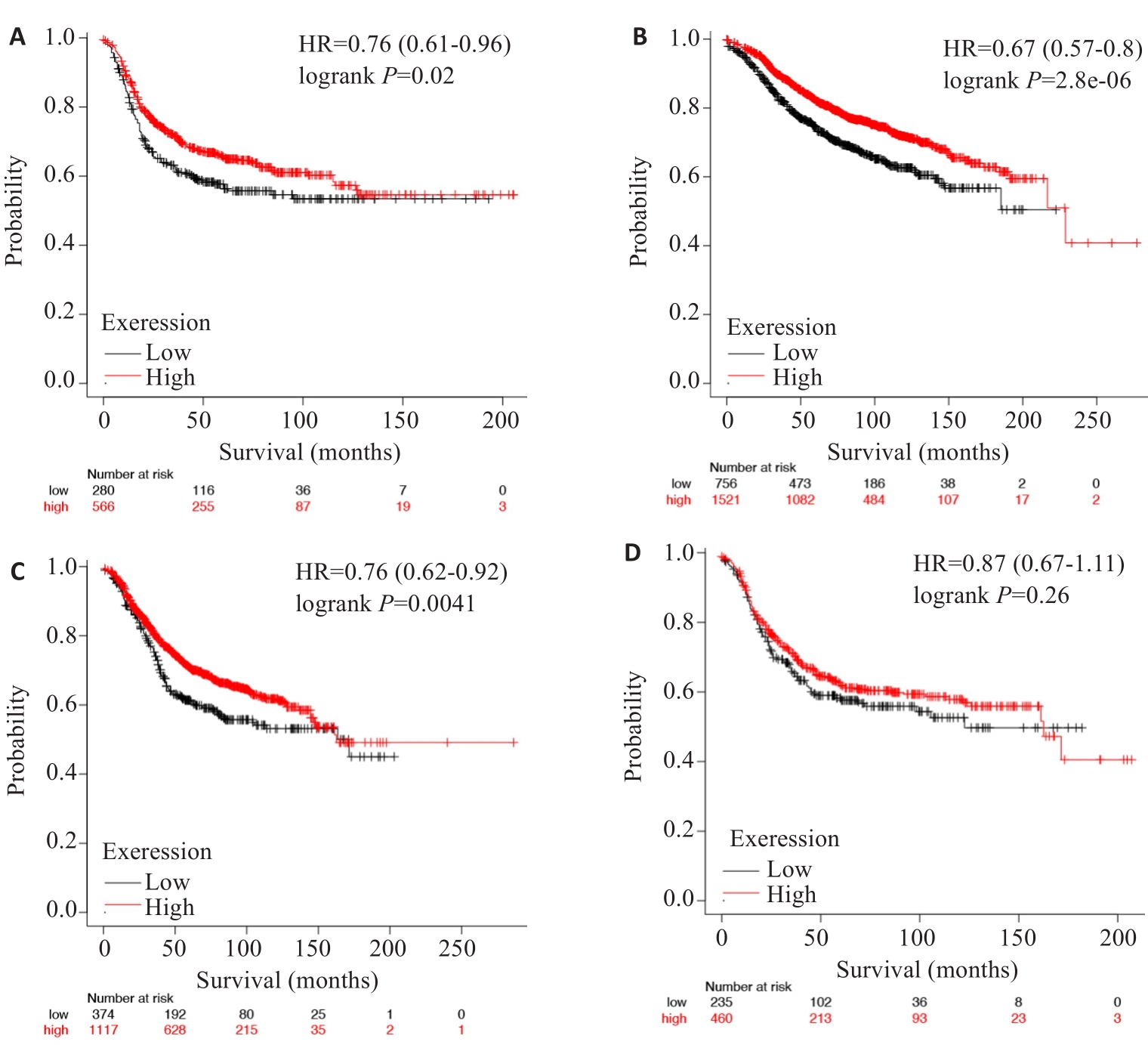
图2 CDHR2在乳腺癌患者中的生存预后
Fig.2 Survival outcomes of breast cancer patients with low and high CDHR2 expressions. A-D: Relationship between CDHR2 expression and prognosis of the patients with triple-negative (A), luminal A (B), luminal B (C), and Her2-overexpressing (D) breast cancer, respectively.
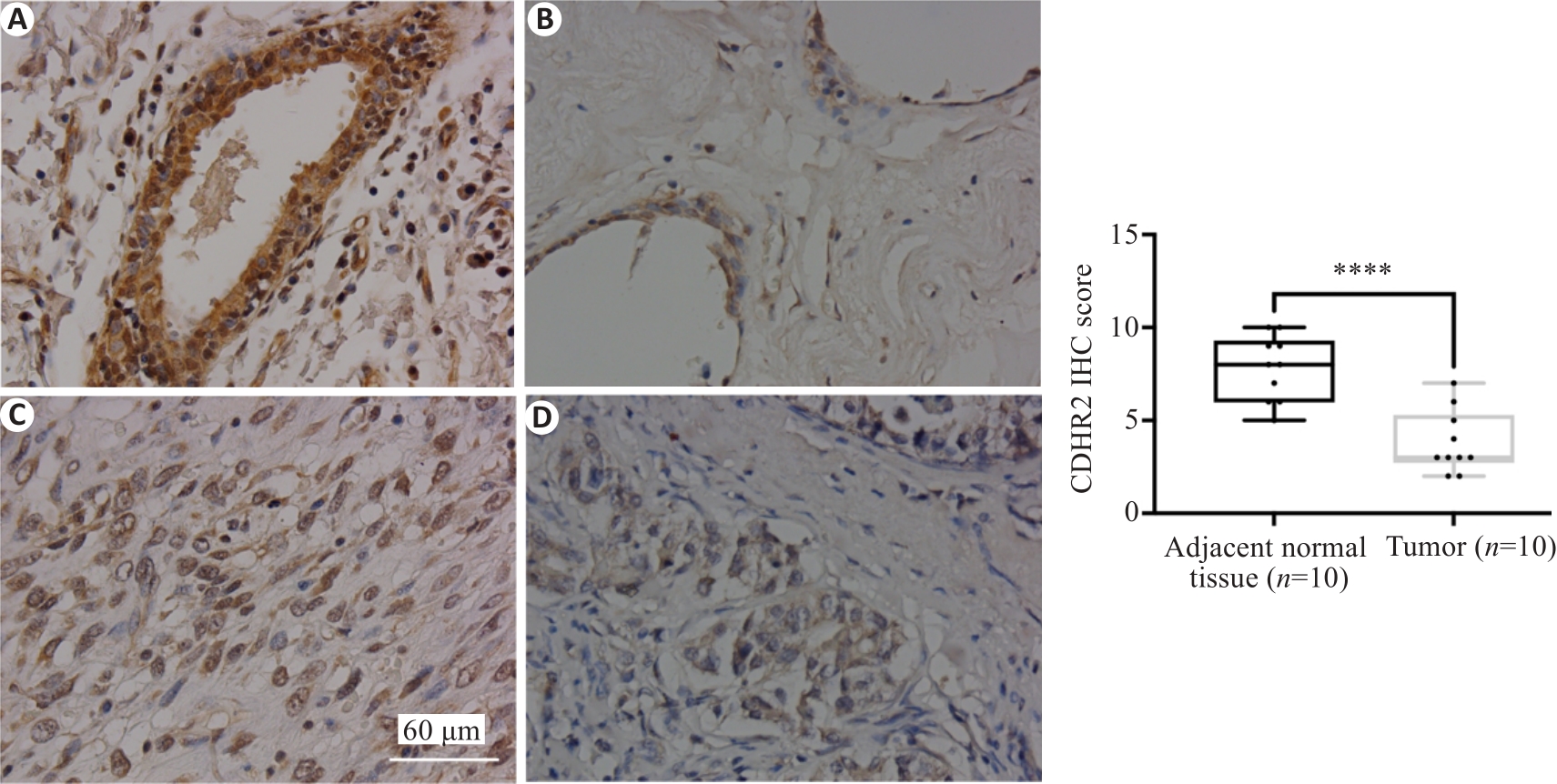
图3 组织中评估CDHR2 的免疫组织化学(IHC)染色强度
Fig.3 Fig. 3 Immunohistochemical staining for CDHR2 in clinical specimens of breast cancer tissues (Original magnification: ×400). A: Strong expression of CDHR2 in breast tissues. B: Weak expression of CDHR2 in breast tissues. C: Strong expression of CDHR2 in breast cancer tissues. D: Weak expression of CDHR2 in breast cancer tissues. ****P<0.0001.
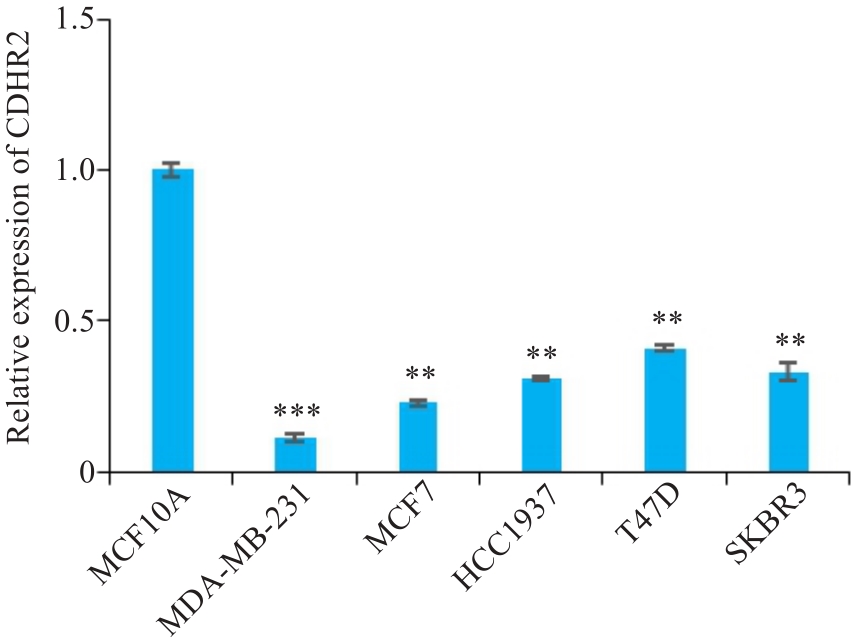
图4 乳腺癌细胞系以及正常人乳腺上皮细胞中CDHR2的mRNA表达水平
Fig.4 CDHR2 mRNA expression levels in breast cancer cell lines and normal human mammary epithelial cells. **P<0.01, ***P<0.001 vs MCF10A.
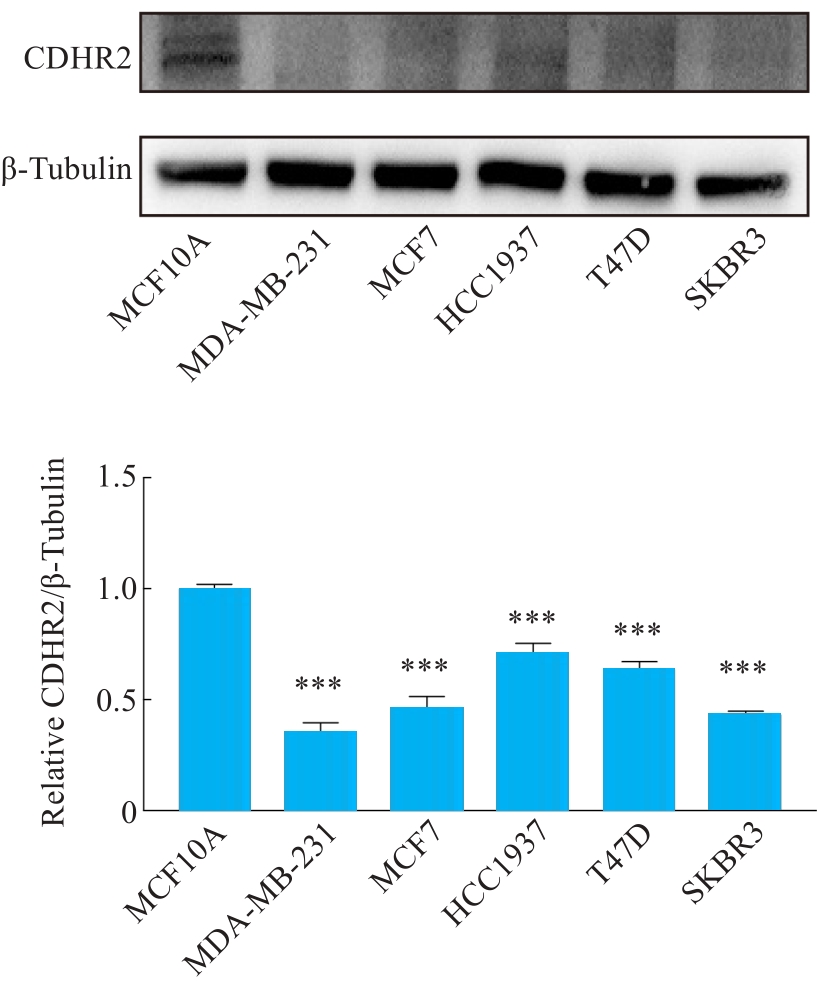
图5 乳腺癌细胞系以及正常人乳腺上皮细胞中CDHR2的蛋白表达水平及统计学分析
Fig.5 CDHR2 protein expression levels in breast cancer cell lines and normal human mammary epithelial cells detected by Western blotting. ***P<0.001 vs MCF10A.
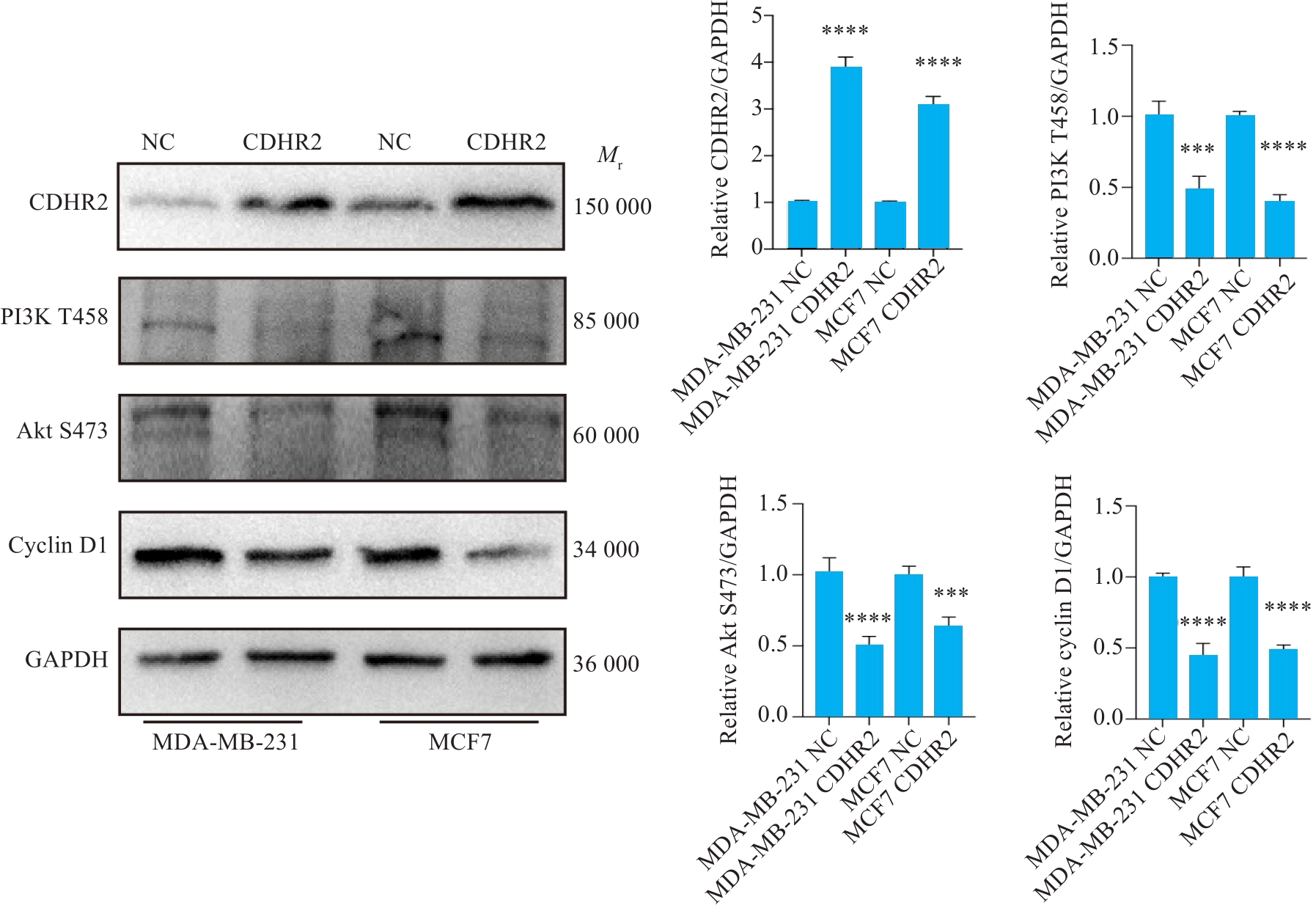
图10 Western blotting检测CDHR2对PI3K/Akt信号通路和Cyclin D1蛋白表达影响及统计学分析
Fig.10 Western blotting of PI3K/Akt signaling pathway proteins and cyclin D1 in the transfected cells. ***P<0.001, ****P<0.0001 vs negetive control (NC).
| 1 | Siegel RL, Miller KD, Wagle NS, et al. Cancer statistics, 2023[J]. CA Cancer J Clin, 2023, 73(1): 17-48. |
| 2 | Kawiak A. Molecular research and treatment of breast cancer[J]. Int J Mol Sci, 2022, 23(17): 9617. |
| 3 | An JS, Peng C, Tang HL, et al. New advances in the research of resistance to neoadjuvant chemotherapy in breast cancer[J]. Int J Mol Sci, 2021, 22(17): 9644. |
| 4 | Barzaman K, Karami J, Zarei Z, et al. Breast cancer: biology, biomarkers, and treatments[J]. Int Immunopharmacol, 2020, 84: 106535. |
| 5 | Pancho A, Aerts T, Mitsogiannis MD, et al. Protocadherins at the crossroad of signaling pathways[J]. Front Mol Neurosci, 2020, 13: 117. |
| 6 | Yu JS, Koujak S, Nagase S, et al. PCDH8, the human homolog of PAPC, is a candidate tumor suppressor of breast cancer[J]. Oncogene, 2008, 27(34): 4657-65. |
| 7 | Harada H, Miyamoto K, Yamashita Y, et al. Prognostic signature of protocadherin 10 methylation in curatively resected pathological stage I non-small-cell lung cancer[J]. Cancer Med, 2015, 4(10): 1536-46. |
| 8 | Haruki S, Imoto I, Kozaki KI, et al. Frequent silencing of protocadherin 17, a candidate tumour suppressor for esophageal squamous cell carcinoma[J]. Carcinogenesis, 2010, 31(6): 1027-36. |
| 9 | Fang S, Huang SF, Cao J, et al. Silencing of PCDH10 in hepatocellular carcinoma via de novo DNA methylation independent of HBV infection or HBX expression[J]. Clin Exp Med, 2013, 13(2): 127-34. |
| 10 | Lei SY, Zheng RS, Zhang SW, et al. Global patterns of breast cancer incidence and mortality: a population-based cancer registry data analysis from 2000 to 2020[J]. Cancer Commun, 2021, 41(11): 1183-94. |
| 11 | Chodosh LA. Breast cancer: current state and future promise[J]. Breast Cancer Res, 2011, 13(6): 113. |
| 12 | McDonald ES, Clark AS, Tchou J, et al. Clinical diagnosis and management of breast cancer[J]. J Nucl Med, 2016, 57(): 9S-16S. |
| 13 | Griguolo G, Pascual T, Dieci MV, et al. Interaction of host immunity with HER2-targeted treatment and tumor heterogeneity in HER2-positive breast cancer[J]. J Immunother Cancer, 2019, 7(1): 90. |
| 14 | Vega-Benedetti AF, Loi E, Moi L, et al. Clustered protocadherins methylation alterations in cancer[J]. Clin Epigenetics, 2019, 11(1): 100. |
| 15 | Imoto I, Izumi H, Yokoi S, et al. Frequent silencing of the candidate tumor suppressor PCDH20 by epigenetic mechanism in non-small-cell lung cancers[J]. Cancer Res, 2006, 66(9): 4617-26. |
| 16 | Wang CL, Yu GZ, Liu JC, et al. Downregulation of PCDH9 predicts prognosis for patients with glioma[J]. J Clin Neurosci, 2012, 19(4): 541-5. |
| 17 | Zhen YL, Pavez M, Li XY. The role of Pcdh10 in neurological disease and cancer[J]. J Cancer Res Clin Oncol, 2023, 149(10): 8153-64. |
| 18 | Xia ZY, Huang MJ, Zhu QQ, et al. Cadherin related family member 2 acts As A tumor suppressor by inactivating AKT in human hepatocellular carcinoma[J]. J Cancer, 2019, 10(4): 864-73. |
| 19 | Okazaki N, Takahashi N, Kojima SI, et al. Protocadherin LKC, a new candidate for a tumor suppressor of colon and liver cancers, its association with contact inhibition of cell proliferation[J]. Carcinogenesis, 2002, 23(7): 1139-48. |
| 20 | Ose R, Yanagawa T, Ikeda S, et al. PCDH24-induced contact inhibition involves downregulation of beta-catenin signaling[J]. Mol Oncol, 2009, 3(1): 54-66. |
| 21 | Luo J, Yao JF, Deng XF, et al. 14, 15-EET induces breast cancer cell EMT and cisplatin resistance by up-regulating integrin αvβ3 and activating FAK/PI3K/AKT signaling[J]. J Exp Clin Cancer Res, 2018, 37(1): 23. |
| 22 | Spangle JM, Dreijerink KM, Groner AC, et al. PI3K/AKT signaling regulates H3K4 methylation in breast cancer[J]. Cell Rep, 2016, 15(12): 2692-704. |
| 23 | Xu JC, Chen TY, Liao LT, et al. NETO2 promotes esophageal cancer progression by inducing proliferation and metastasis via PI3K/AKT and ERK pathway[J]. Int J Biol Sci, 2021, 17(1): 259-70. |
| 24 | Wang Q, He GP, Hou MM, et al. Cell cycle regulation by alternative polyadenylation of CCND1[J]. Sci Rep, 2018, 8(1): 6824. |
| 25 | Hermosilla VE, Salgado G, Riffo E, et al. SALL2 represses cyclins D1 and E1 expression and restrains G1/S cell cycle transition and cancer-related phenotypes[J]. Mol Oncol, 2018, 12(7): 1026-46. |
| 26 | Feng YF, Qian WW, Zhang Y, et al. CDCA2 promotes the proliferation of colorectal cancer cells by activating the AKT/CCND1 pathway in vitro and in vivo [J]. BMC Cancer, 2019, 19(1): 576. |
| 27 | Xie ZZ, Li W, Ai JG, et al. C2orf40 inhibits metastasis and regulates chemo-resistance and radio-resistance of nasopharyngeal carcinoma cells by influencing cell cycle and activating the PI3K/AKT/mTOR signaling pathway[J]. J Transl Med, 2022, 20(1): 264. |
| 28 | Zhong Y, Yang LT, Xiong F, et al. Long non-coding RNA AFAP1-AS1 accelerates lung cancer cells migration and invasion by interacting with SNIP1 to upregulate c-Myc[J]. Signal Transduct Target Ther, 2021, 6(1): 240. |
| 29 | Kar G, Gursoy A, Keskin O. Human cancer protein-protein interaction network: a structural perspective[J]. PLoS Comput Biol, 2009, 5(12): e1000601. |
| 30 | Cho HJ, Hwang YS, Yoon J, et al. EphrinB1 promotes cancer cell migration and invasion through the interaction with RhoGDI1[J]. Oncogene, 2018, 37(7): 861-72. |
| [1] | 谢婷, 王云云, 郭婷, 袁春华. 雷氏大疣蛛多肽毒素组分通过激活促凋亡通路和协同作用抑制癌细胞增殖[J]. 南方医科大学学报, 2025, 45(7): 1460-1470. |
| [2] | 李嘉豪, 冼瑞婷, 李荣. 下调ACADM介导的脂毒性抑制雌激素受体阳性乳腺癌细胞的侵袭与转移[J]. 南方医科大学学报, 2025, 45(6): 1163-1173. |
| [3] | 曾玉梅, 李继科, 黄仲曦, 周毅波. 绒毛样蛋白VILL通过与LMO7蛋白相互作用抑制鼻咽癌细胞的增殖[J]. 南方医科大学学报, 2025, 45(5): 954-961. |
| [4] | 岳雅清, 牟召霞, 王希波, 刘艳. Aurora-A过表达通过激活NF-κBp65/ARPC4信号轴促进宫颈癌细胞的侵袭和转移[J]. 南方医科大学学报, 2025, 45(4): 837-843. |
| [5] | 张毅, 沈昱, 万志强, 陶嵩, 柳亚魁, 王栓虎. CDKN3高表达促进胃癌细胞的迁移和侵袭:基于调控p53/NF-κB信号通路和抑制胃癌细胞凋亡[J]. 南方医科大学学报, 2025, 45(4): 853-861. |
| [6] | 庆顺杰, 沈智勇. 过表达己糖激酶2通过激活JAK/STAT途径促进结直肠癌细胞的增殖、迁移和侵袭并调节肿瘤免疫微环境[J]. 南方医科大学学报, 2025, 45(3): 542-553. |
| [7] | 黄晴晴, 张文静, 张小凤, 王炼, 宋雪, 耿志军, 左芦根, 王月月, 李静, 胡建国. 高表达MYO1B促进胃癌细胞增殖、迁移和侵袭并与患者的不良预后有关[J]. 南方医科大学学报, 2025, 45(3): 622-631. |
| [8] | 宋雪, 陈悦, 张敏, 张诺, 左芦根, 李静, 耿志军, 张小凤, 王月月, 王炼, 胡建国. GPSM2在胃癌组织中高表达并通过促进肿瘤细胞的增殖影响患者预后[J]. 南方医科大学学报, 2025, 45(2): 229-238. |
| [9] | 陈镝, 吕莹, 郭怡欣, 张怡荣, 王蕊璇, 周小若, 陈雨欣, 武晓慧. 双氢青蒿素可显著增强阿霉素诱导的三阴性乳腺癌细胞凋亡:基于负向调控STAT3/HIF-1α通路[J]. 南方医科大学学报, 2025, 45(2): 254-260. |
| [10] | 邹金华, 王惠, 张冬艳. SLC1A5通过促进M2型巨噬细胞极化促进肝癌进展[J]. 南方医科大学学报, 2025, 45(2): 269-284. |
| [11] | 宾禹, 李子雯, 左素微, 孙思诺, 李敏, 宋佳茵, 林旭, 薛刚, 吴靖芳. 载脂蛋白C1高表达通过激活JAK2/STAT3信号通路促进甲状腺乳头状癌细胞的增殖并抑制凋亡[J]. 南方医科大学学报, 2025, 45(2): 359-370. |
| [12] | 曹周芳, 汪元, 王梦娜, 孙玥, 刘菲菲. LINC00837/miR-671-5p/SERPINE2功能轴促进类风湿关节炎成纤维细胞样滑膜细胞的恶性病理学过程[J]. 南方医科大学学报, 2025, 45(2): 371-378. |
| [13] | 褚乔, 王小娜, 续佳颖, 彭荟林, 赵裕琳, 张静, 陆国玉, 王恺. 白头翁皂苷D通过多靶点和多途径抑制三阴性乳腺癌侵袭转移[J]. 南方医科大学学报, 2025, 45(1): 150-161. |
| [14] | 陈孝华, 鲁辉, 王子良, 王炼, 夏勇生, 耿志军, 张小凤, 宋雪, 王月月, 李静, 胡建国, 左芦根. ABI2在胃癌进展和预后中的作用及其调控机制[J]. 南方医科大学学报, 2024, 44(9): 1653-1661. |
| [15] | 薛良军, 谈秋瑜, 许静文, 冯璐, 李文锦, 颜亮, 李玉磊. MiR-6838-5p过表达下调DDR1基因表达抑制乳腺癌MCF-7细胞的增殖[J]. 南方医科大学学报, 2024, 44(9): 1677-1684. |
| 阅读次数 | ||||||
|
全文 |
|
|||||
|
摘要 |
|
|||||